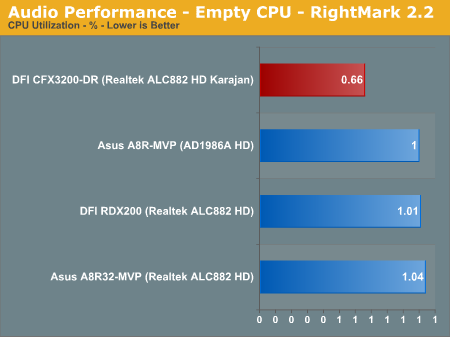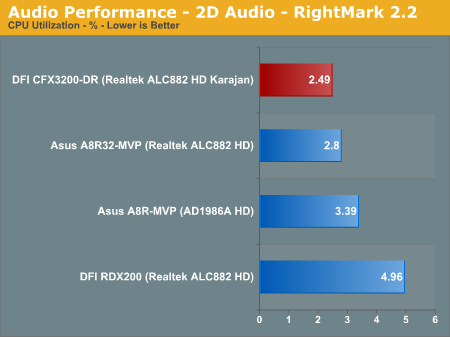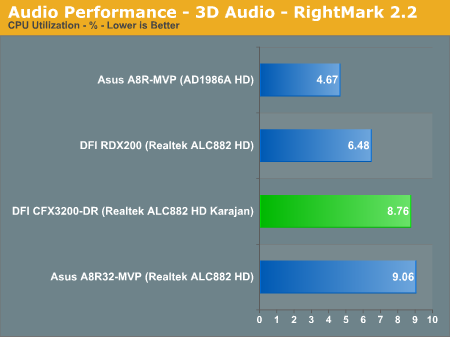DFI CFX3200-DR: ATI RD580 Tweak Attack
by Wesley Fink on May 8, 2006 12:05 AM EST- Posted in
- Motherboards
Audio Performance
Audio testing used the latest version 2.2 of the Rightmark 3D Sound CPU utilization test. This benchmark measures the overhead or CPU utilization required by a codec or hardware audio chip. Versions earlier than 2.2 would not work properly on the RD580 chipset based A8R32-MVP.


The High Definition audio codecs have generally shown lower CPU utilization in audio benchmarking than earlier AC'97 audio solutions. The Empty CPU and 2D Audio both showed extremely low utilization scores on the DFI, with values of less than 1% in Empty CPU and less than 3% in 2D. However, 3D audio on the Karajan module with the Realtek ALC882 was around 9% - much lower than the 30 to 40% we have seen in the past but still enough to steal a few frames-per-second from games. The most demanding 3D+EAX test showed even lower CPU utilization at 8.48%. In HD audio the Karajan module does not appear to lower CPU utilization compared to the on-board ALC882 used on competing boards.
Realtek has been very consistent in recent months in releasing regular updates to their HD audio drivers, and we suspect that trend will continue with ATI and Intel both firmly committed to HD and NVIDIA also introducing hew HD solutions. Each new Realtek update has lowered CPU utilization and we hope that will continue.
ATI chipset motherboards have the necessary hooks to deliver Azalia High Definition audio. Those who have been complaining about the poor AC'97 audio present on most AMD boards should be very pleased to find Azalia HD on the ATI chipset boards. The nForce4 family does not offer the necessary chipset hooks to support HD Azalia audio on their top Athlon 64 chipsets. However, recent introductions by NVIDIA have included the HD audio option and we expect future NVIDIA chipsets to offer this feature. We also expect upcoming NVIDIA high-end chipsets will soon be supporting HD audio.










25 Comments
View All Comments
Stele - Wednesday, May 10, 2006 - link
IMHO the main disadvantage of using the Sil3114 instead of a newer SATA controller like the 3132 is not so much the 1.5Gbps transfer rate, but the fact that it's PCI-based and hence badly bottlenecked once you fill all four channels. 1.5Gbps is a theoretical maximum and HDDs today are nowhere near that limit - in fact we left ATA-133 without even breaking the ATA-100 limit. Since each SATA HDD gets a dedicated 1.5Gbps channel, arrays won't saturate the SATA interface either - rather, they would saturate the slow PCI interface as previously mentioned. Furthermore, the other significant feature of SATA II - NCQ - is of virtually zero relevance to most users, unless one is using the board in a corporate server; not impossible, but not likely either. Therefore, to harp on a figure that has generally been more a marketing tool (as was ATA-133) than a real necessity says little of the real issues at hand.In return, using the Sil3114 means using a tried and tested product whose characteristics are very well known by now. Board engineers would know how best to design around it - what special requirements (signal integrity, trace lengths, coupling etc), if any, need to be factored in, how the controller performs and behaves and so on. Furthermore, the 3114 provides 4 SATA ports for maximum expansion capability - there is no 4-port version of the 3132 as you alluded to in the review - not yet anyway. You may well be right about having a truckload of 3114s to get rid off, so that's likely a factor too. Perhaps when the 3132 gains a 4-port counterpart (and DFI finishes off 3114 inventory) then we may see newer stuff to come. :)
On another side note, yes there would probably be many people who would appreciate the insane options in BIOS, but I do agree that they should make the UI more user-friendly, e.g. by having Automatic as a choice and/or by placing advanced options in sub-menus to distinguish them from the main options. That would satisfy enthusiasts of all levels, from the mad hatters down to the ones who are just starting out. :)
Generally a review well done! :)
Stele - Wednesday, May 10, 2006 - link
Perhaps that statement should be clarified/qualified a little - there is no 4-port version of the 3132 (i.e. PCIe + SATA II + 3.0Gbps) in a single controller IC. The 3132 supports, and hence is expected to be used with, SATA port multipliers - primarily the SII 3726, which can support up to 5 drives. In future, DFI could use a 3132 with one SATA channel routed to an external connector (as in the Asus A8N32-SLI) while the other channel could be connected to a 3726 to provide an additional 4 or even 5 internal HDD channels.
However, this would create two problems - the need for another IC (the board is already very cramped as it is!) and, as already discussed, the need to gain sufficient experience with the new ICs in the lab before they can be confidently implemented and designed around. Cost and time-to-market factors may also have played a role in DFI's choice.
proamerica - Monday, May 8, 2006 - link
This is a poor quality review. The reviewer complains too much about variables that actually improve performance when handled by the right person. The overclocking potential of this board is beyond all other 939 boards I have owned, including the A8R32-MVP... People all over the place are reporting the highest overclocks ever achieved for memory and CPUs. You have to know what you are doing I'm afraid, and yes it requires using all the settings in the BIOS. That is the caveat of buying this board, its hard to use, and it takes time to figure it out, but once you do its worth it. I stably OC'ed my X2 3800 to 2940Mhz, and I currently run it 24/7 at 2700Mhz. Is 2940Mhz the highest OC I have ever gotten with this processor? Yes, stably, by far the highest. One of the greatest aspects of this board is that it will overclock really high but it doesn't take a lot of voltage to get things stable.Why does the review say: "but this DFI does make us wonder how many end users will actually devote the time to master 32 levels of drive strength, and DQS skew levels of +/- 0 to 255 in 511 levels." Lets see, an extremely expensive motherboard from a company known for making the most tweakable boards around... And you wonder if end-users are going to bother? Yeah they're going to bother. If they don't, they should have purchased something else.
Bottom line, this board beats the A8R32-MVP hands down, its just harder to use than the Asus.
Wesley Fink - Tuesday, May 9, 2006 - link
The review pointed out what you clearly found. It's a difficult board to master, but the options and performance can be outstanding. Some want to take the time to master it, others would prefer a board that is easier to overclock. The real poiunt is the DFI CFX3200 still needs work. The BIOS does NOT need to be so difficult to master, and it wouldn't be if more intelligent choices were made for auto settings.The CFX3200 is not a bad board, it is just a very difficult board to use and master - even for an experienced enthusiast.
Zoomer - Wednesday, May 10, 2006 - link
As mentioned by someone else, the auto (default) settings are nicely choosen - for BH5 memory.Perhaps it would be wise to point that out somewhere, or provide an option of memory: BH5/Normal/Valueram/Manual
ozzimark - Monday, May 8, 2006 - link
"Running four double-sided 512MB or 1GB DIMMs is much more demanding than running two DS DIMMs, and like almost every board we have tested the Command Rate needed to drop to 2T with 4 DS DIMMs."using a high dram drive strength should allow for stable opteration at 1T with 4 double rank sticks in.. :)
bigtoe36 - Monday, May 8, 2006 - link
From the Tweak guide on the bleedinedge forum."Max async latency - options 7 thru 10 are all you should need, 7 for agressive tight timings 10 for high fsb overclocks. This option HAS TO BE SET MANUALLY
Read Preamble - 4.5 thru 6 is all you need worry about, 4.5 for BH5 etc and 6 for high fsb overclocks. i usually use 5.5 and 6. Again HAS TO BE SET MANUALLY"
http://www.bleedinedge.com/forum/showthread.php?t=...">http://www.bleedinedge.com/forum/showthread.php?t=... for the full guide.
Wesley you have the options posted on page 4 the wrong way round, its easy to do as I often get them confused.
Tony
ozzimark - Monday, May 8, 2006 - link
with dfi boards, it's long been my experience that manually setting MAL/RP is a VERY BAD thing.bigtoe36 - Monday, May 8, 2006 - link
Normally that would be the case but DFI were setting 4.5 and 5 as hidden defaults. Now if you are running Bh5 you will have no problems, but most everything else would have issues.Thats why i quoted in my guide and on MANY forums you have to set these manually to get the best from the board.
mbhame - Monday, May 8, 2006 - link
Where's the USB/Firewire CPU Utilization and I/O? Where's IDE performance?Throughput is not indicative of real-world performance for any user I know.